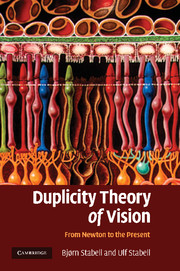Book contents
- Frontmatter
- Contents
- Acknowledgements
- 1 Introduction
- Part I The development of the basic ideas of the duplicity theory from Newton to G. E. Müller
- Part II The development of the duplicity theory from 1930–1966
- Part III Chromatic rod vision: a historical account
- Part IV Theories of sensitivity regulation of the rod and cone systems: a historical account
- 15 Introduction
- 16 Early photochemical explanations
- 17 Contribution of S. Hecht
- 18 Contribution of G. Wald: photochemical sensitivity regulation mechanisms of rods and cones
- 19 Relationship between amount of rhodopsin and sensitivity during dark adaptation
- 20 Post-receptor sensitivity regulation mechanisms
- 21 Rushton's AGC model
- 22 Contribution of H.B. Barlow
- 23 Rushton and Barlow compared
- 24 The Dowling-Rushton equation refuted
- 25 Several mechanisms involved in sensitivity regulation
- 26 Sensitivity regulation due to rod-cone interaction
- 27 Modern conceptions of sensitivity regulation
- Part V Factors that triggered the paradigm shifts in the development of the duplicity theory
- References
- Index
23 - Rushton and Barlow compared
Published online by Cambridge University Press: 22 January 2010
- Frontmatter
- Contents
- Acknowledgements
- 1 Introduction
- Part I The development of the basic ideas of the duplicity theory from Newton to G. E. Müller
- Part II The development of the duplicity theory from 1930–1966
- Part III Chromatic rod vision: a historical account
- Part IV Theories of sensitivity regulation of the rod and cone systems: a historical account
- 15 Introduction
- 16 Early photochemical explanations
- 17 Contribution of S. Hecht
- 18 Contribution of G. Wald: photochemical sensitivity regulation mechanisms of rods and cones
- 19 Relationship between amount of rhodopsin and sensitivity during dark adaptation
- 20 Post-receptor sensitivity regulation mechanisms
- 21 Rushton's AGC model
- 22 Contribution of H.B. Barlow
- 23 Rushton and Barlow compared
- 24 The Dowling-Rushton equation refuted
- 25 Several mechanisms involved in sensitivity regulation
- 26 Sensitivity regulation due to rod-cone interaction
- 27 Modern conceptions of sensitivity regulation
- Part V Factors that triggered the paradigm shifts in the development of the duplicity theory
- References
- Index
Summary
As can be seen, the theories of light and dark adaptation proposed by Rushton and Barlow disagreed both with regard to the site of the gain-determining mechanisms and the question of whether light and dark adaptation were equivalent.
In the 1965 version, Rushton held that the two processes were controlled in an AGC pool located centrally to the photoreceptors, while in the 1972 version he suggested that dark adaptation mainly occurred in the receptors and light adaptation in horizontal cells. In both versions he held that light and dark adaptation were quite different processes.
The noise theory of Barlow, on the other hand, presumed that light- and dark-adaptation processes were equivalent and located mainly in the receptors – that light adaptation mainly resulted from statistical fluctuation of photons of the background light, while dark adaptation was controlled by photon-like events, possibly originating from photoproducts as a stream of events fluctuating randomly like the photons.
Information
- Type
- Chapter
- Information
- Duplicity Theory of VisionFrom Newton to the Present, pp. 174Publisher: Cambridge University PressPrint publication year: 2009
